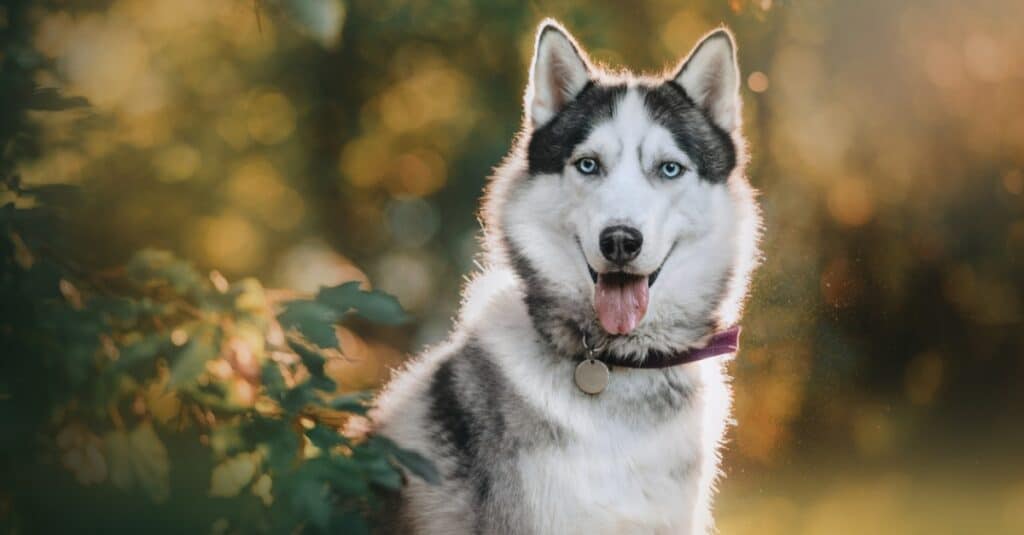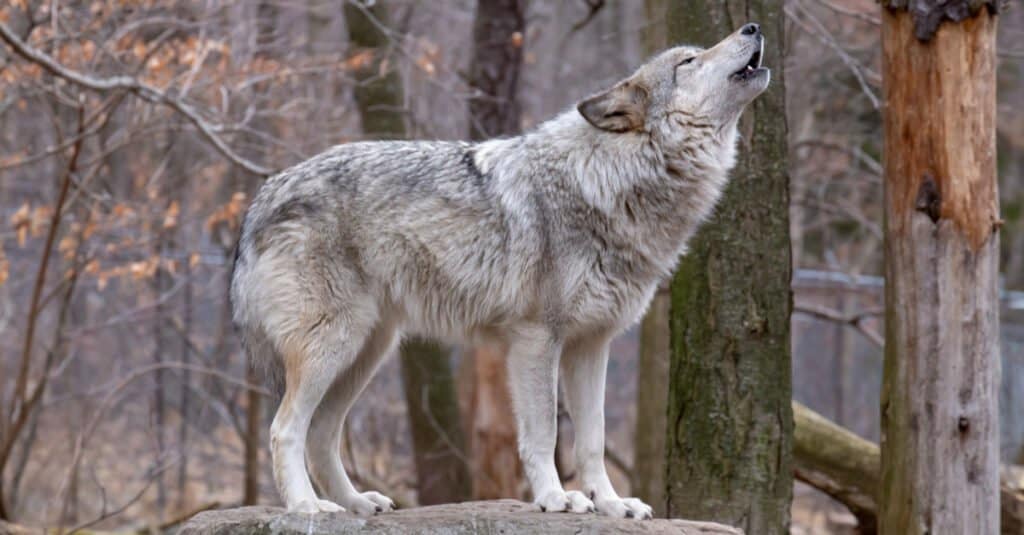Huskies vs Wolves: 8 Key Differences Explained
↓ Keep reading to watch this amazing video
What is the difference between a husky and a wolf? Despite their similar appearance, there is a big gap between domesticated huskies and wild wolves. According to the fossil record, humans first domesticated dogs between 20,000 and 40,000 years ago, and the oldest examples of humans and dogs being buried together date back to about 15,000 years ago. Although they may share a common ancestor, huskies and wolves represent different species. That said, many people often confuse these canines due to the color, shape, and "wolffish" appearance. In this article, we will discuss the 8 main differences that distinguish huskies from wolves. Additionally, we'll discuss several frequently asked questions about huskies and wolves.
Comparing Huskies and Wolves
The only officially recognized husky breed is the Siberian Husky. A member of the Spitz genetic family, the Siberian Husky hails from the Arctic tundra of Northeast Asia. Originally, the Chukchi people of Siberia bred huskies for sledding and as companion dogs. That said, several unofficial husky breeds also exist. While these breeds bear the "husky" moniker, they won't be the focus of our comparison, but we'll still briefly describe them in order to differentiate them from the Siberian Husky.
alaskan malamute
The Malamute is a crossbreed that represents a mix of different breeds, including English Pointers, German Shepherds, and Salukis. Originally bred in Alaska as sled dogs, they lack the typical "wolffish" look of other huskies.
labrador husky
The Labrador Husky gets its name from the fact that it originated in the Labrador region of Canada. For hundreds of years, the Inuit people of the region have bred Labrador huskies as working dogs. Despite its name, the Labrador Husky is not related to the Labrador, but to the Canadian Eskimo Dog.
Mackenzie River Sled Dogs
Mackenzie River Sled Dogs represent a mix of several different breeds, including St. Bernards and Newfoundlands. Originally from the Yukon Territory of Canada, the MacKenzie River Husky was bred to be a powerful sled dog capable of living and working in harsh conditions.
sakhalin husky
The Sakhalin Husky is a recently extinct breed native to the Japanese island of Sakhalin. Its Japanese name is karafuto ken, which means "Sakhalin dog". Originally bred as sled dogs, only two purebred Sakhalin Huskies remained in 2011, making the breed functionally extinct.
At the same time, the word wolf is used to cover nearly 40 subspecies. However, several branches exist within the wolf family. Typically, three classifications emerge that help differentiate certain wolf populations. These groups include gray wolves, timber wolves, and red wolves. Of the three, gray wolves are the most common, referring to any number of subspecies from Eurasia and North America. Therefore, we will use a typical gray wolf for our comparison, but will briefly describe gray and red wolves for reference.
big bad wolf
Timber wolf is not a distinct species, but a term used to cover several subspecies of North American wolves. In general, the term is most often associated with the eastern wolf, also known as the timber wolf or the Algonquin wolf. It is native to the Great Lakes and southeastern Canada. Additionally, the term is sometimes used to refer to the Northern Rocky Mountain wolf and the Northwest wolf (also known as the Mackenzie Valley wolf and the Alaskan or Canadian Timber wolf).
red wolf

© mruizseda/Shutterstock.com
Red wolf is the term used to describe a group of wolves native to the southeastern United States. The appearance of the red wolf, which resembles a hybrid of a coyote and a wolf, has been debated endlessly.
| hoarse | Wolf | |
| Habitat and distribution | The whole world originally came from Siberia's arctic tundra | North America, Eurasia, North Africa |
| size | 21 to 23.5 inches tall (male) 20 to 22 inches tall (female) 45 to 60 pounds (male) 35 to 50 pounds (female) |
26 to 33 inches tall 85 lbs (European wolf) 79 lbs (North American wolf) up to 190 lbs |
| life | 12 to 15 years old | 6 to 8 years old (wild ) for up to 20 years in captivity |
| coat and coloring | Double coat with short hair colors including red, black, gray, sable, white and agouti | Double coat, long hair Coarse hair Tufts on the cheeks are usually gray |
| Eye | Brown, blue, or black eyes Heterochromia amygdala is common | Yellow, amber, or brown eyes rounder eyes |
| Body | Shorter muzzle, thinner body, upper ears and longer, streaked forehead, narrow chest, short legs, small head, black or pink nose | Longer muzzle, thicker body, more triangular ear offset, wider chest, longer legs, larger head, black nose |
| teeth | shorter | longer |
| temperament and socialization | Domesticated, easy to train, dependent on owner, have fun | Wilderness resistance training Independent game play to learn hunting skills |
8 Key Differences Between Huskies and Wolves

©Ksenia Raykova/Shutterstock.com
Huskies vs. Wolves: Habitat and Distribution
The first difference between huskies and wolves has to do with their habitat and distribution. As a domesticated breed, huskies can be found all over the world. That is, they are adapted to life in cold climates and do not tolerate high temperatures very well. Huskies originated in the arctic tundra of Siberia, and the breed may be as old as 4,000 years. Meanwhile, the wolf's range extends across North America, Eurasia, and parts of Africa. Unlike huskies, some wolves have adapted to warmer climates. In these regions, wolves tend to have shorter and thicker coats, as opposed to the longer coats of wolves at higher latitudes.
Huskies vs Wolves: Dimensions
The most notable difference between huskies and wolves is their respective body sizes. Almost every wolf subspecies is larger than the largest husky. Typically, male huskies are 21 to 23.5 inches tall at the shoulder and weigh between 45 and 60 pounds. Female huskies are slightly smaller, standing 20 to 22 inches tall and weighing 35 to 50 pounds. Wolves, on the other hand, can stand anywhere from 26 to 33 inches tall. While Eurasian wolves tend to be heavier than North American wolves, some North American wolf subspecies can grow exceptionally large. The average European wolf weighs about 85 pounds and the average North American wolf weighs 79 pounds. That said, there are records of wolves weighing up to 190 pounds.
Huskies vs Wolves: Lifespan
On average, huskies tend to live longer than wolves. Huskies have an average lifespan of 12 to 15 years. Meanwhile, most wolves live only 6 to 8 years in the wild. Wolves face a variety of threats, including threats from other predators, hunters, disease, cold and the environment. Thus, a wolf's life can end in a dirty, brutal and short-lived way. However, wolves in captivity can live up to 20 years old, although most don't live that long.
Huskies vs Wolves: Coats and Coloring
While they both grow a double coat, huskies and wolves don't have identical coats. Huskies generally have shorter coats than wolves. Additionally, Huskies come in a variety of colors, including black, gray, red, white, sable, and agouti. Meanwhile, wolves often grow longer fur, especially those that live in colder climates. Their coat is thicker than that of the husky, which is more shaggy. Additionally, wolves typically grow tufts of hair on the cheeks and thick hair around the chest and neck. While wolves can come in a variety of colors, they are usually gray with white and black markings.
Husky vs Wolf: Eyes
It's hard to mistake a husky's eyes for a wolf's. Huskies have brown, blue or black eyes. However, heterochromia is common in huskies, so a single husky may have two different colored eyes. Their eyes are almond-shaped, and many owners consider their eyes to be one of their most distinctive features. On the other hand, wolves usually have yellow, amber, or brown eyes. Additionally, their eyes are rounder than those of a husky and generally have a wilder appearance.
Huskies vs. Wolves: Body
There are some subtle differences in body composition that can help you differentiate a husky from a wolf. Huskies have shorter muzzles than wolves, although wolves tend to have narrower muzzles. A husky's nose can be black or pink, while a wolf's nose is almost always completely black. Additionally, wolves have much larger heads than huskies, and in greater proportion to their bodies. Huskies have a distinctive stripe on their foreheads that wolves don't have. Additionally, wolves tend to have thicker and longer bodies, wider chests and longer legs. Finally, husky ears are erect on top of the head and are fairly long, while wolf ears are slanted and triangular in shape.
Husky vs Wolf: Teeth
Thanks to their shared genes, both huskies and wolves have developed sharp canine teeth specialized for tearing and tearing flesh. However, if you look closely, it's easy to tell the difference between a Husky and a Spike. In general, wolves develop larger, thicker teeth than huskies. While huskies may have grown larger teeth in the past, thousands of years of domestication may have made their teeth smaller. Meanwhile, modern wolves need large, strong teeth to kill prey, tear flesh, and break bones.
Huskies vs Wolves: Temperament and Socialization
While they share some similarities, don't take this to mean that there is no difference in temperament between huskies and wolves. Huskies are domesticated dogs that are adapted to get along with humans. Originally bred as working dogs, Huskies are easy to train and depend on their owners. They will fight, but their fights are usually more for fun than to vent their aggression. Meanwhile, wolves are wild animals. They resist training and possess a cold intelligence that their domesticated cousins lack. Wolves crave independence and freedom, and when they fight, the goal is to learn basic killing skills, not just for fun.
Frequently Asked Questions about Huskies and Wolves

©Allison Coffin/Shutterstock.com
Why do huskies and wolves howl?
Wolves howl for several reasons. They may howl to mark their territory or to find other members. Although huskies are domesticated, they retain the instinctive urge to howl. They may howl when upset, communicate with other dogs, or simply express their feelings.
How many wolves are there?
The report estimates that there are approximately 200-250,000 gray wolves worldwide. Most of them live in Canada, Russia, Alaska and Central Asia.
How Popular Are Huskies?
The American Kennel Club ranks the Husky as the 14th most popular dog breed in the United States. Since the AKC first recognized the breed in 1930, the Husky's popularity has continued to climb.
Next:
- Saw an alligator biting an electric eel with 860 volts
- The 15 Deepest Lakes in America
- Watch rare coyotes and bobcats now
More from AZ Animals
featured image

© AZ-Animals.com website
Thanks for reading! Have some feedback for us? Contact the 10hunting.com editorial team.





